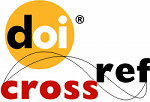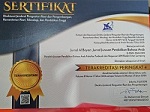Audiolingual Method in Arabic Learning
Abstract
Keywords
Full Text:
PDFReferences
Abdul, Nurdevi Bte. “The Use of Audio-Lingual Method in Teaching Listening Comprehension at the Second Year Students of SMK Yapip Makassar Sungguminasa.” Exposure : Jurnal Pendidikan Bahasa dan Sastra Inggris 5, no. 1 (2016): 43–52. https://doi.org/10.26618/ejpbi.v5i1.808.
Ade Chairil Anwar. “Direct Method dalam Pembelajaran Bahasa Arab di SMA Future Gate Kota Bekasi.” Waraqat: Jurnal Ilmu-Ilmu Keislaman 2, no. 2 (2017) https://doi.org/10.51590/waraqat.v2i2.59.
Akkoyunlu, Buket, and Meryem Yilmaz Soylu. “A Study on Students’ Views on Blended Learning Environment.” Turkish Online Journal of Distance Education 7, no. 3 (2006): 43–56.
Albantani, Azkia Muharom, and Ahmad Madkur. “Musyahadat al Fidyu: Youtube-Based Teaching and Learning of Arabic as Foreign Language (AFL).” Dinamika Ilmu 17, no. 2 (2017): 291–308. https://doi.org/10.21093/di.v17i2.854.
Alem, Dawit Dibekulu. “Approaches and Methods in Language Teaching: A Short Summary.” Noble International Journal of Social Sciences Research 5, no. 9 (2020): 135–151.
Ali, Rab. “A Review of Direct Method and Audio-Lingual Method in English Oral Communication.” International Journal of Scientif & Technology Research 9, no. 8 (2020): 289–293.
Aprianto, Aprianto, Mahyudin Ritonga, Yoni Marlius, and Raihan Nusyur. “The Influence of Using Audio-Lingual Method on Students’ Speaking Skill in Madrasah Diniyah Takmiliyah Awwaliyyah.” Izdihar : Journal of Arabic Language Teaching, Linguistics, and Literature 3, no. 2 (2020): 147–160. https://doi.org/10.22219/jiz.v3i2.12514.
Batool, Nadia, Muhammad Anosh, Anam Batool, and Nadeem Iqbal. “The Direct Method: A Good Start to Teach Oral Language.” Journal of Literature, Languages and Linguistics 5, no. 1 (2017): 37–40.
Bidenko, Larysa, and Hanna Bespalova. “Implementing Audio-Lingual Method to Teaching Ukrainian As a Foreign Language at the Initial Stage.” Advanced Education 3, no. 7 (2017): 23–27. https://doi.org/10.20535/2410-8286.82711.
Dani, Erzsebet. “How ‘Publish or Perish’ Can Become ‘Publish and Perish’ in the Age of Objective Assessment of Scientific Quality.” Systemics, Cybernetics and Informatics 16, no. 4 (2018): 20–25. http://www.iiisci.org/Journal/PDV/sci/pdfs/IP052LL18.pdf.
Daud, Wan Ab Aziz Bin Wan, Kung Teck Wong, Mohammad Taufiq Abdul Ghani, and Saipol Barin Ramli. “Gender Differences in Learning Arabic Language Proficiency via M-Learning among Malaysia University Students.” Journal of Language and Linguistic Studies 17, no. 2 (2021): 1069–82. https://doi.org/10.17263/jlls.904123.
Dayagbil, Filomena T., Daisy R. Palompon, Laurence L. Garcia, and Michelle Mae J. Olvido. “Teaching and Learning Continuity Amid and Beyond the Pandemic.” Frontiers in Education 6, (2021): 1–12. https://doi.org/10.3389/feduc.2021.678692.
Djauhar, Risnawati. “The Grammar - Translation Method , The Direct Method , and The Audio-Lingual Method.” Langua – Journal of Linguistics, Literature, and Language Education 4, no. 1 (2021): 84–88. https://doi.org/https://doi.org/10.5281/zenodo.4642999.
Dunlosky, John, Katherine A. Rawson, Elizabeth J. Marsh, Mitchell J. Nathan, and Daniel T. Willingham. “Improving Students’ Learning with Effective Learning Techniques: Promising Directions from Cognitive and Educational Psychology.” Psychological Science in the Public Interest, Supplement 14, no. 1 (2013): 4–58. https://doi.org/10.1177/1529100612453266.
Farid, Edi Kurniawan, Mamluatun Ni’mah, and Nur Arifah. “The Teaching of the Speaking Skill Using the Audio-Oral Method for The Students of Islamic Senior High School of Zainul Hasan Genggong Probolinggo.” Mantiqu Tayr: Journal of Arabic Language 1, no. 1 (2021): 1–10. https://doi.org/10.25217/mantiqutayr.v1i1.1197.
Fauzi, Muhammad Sya’dullah. “Eksperimentasi Model Pembelajaran Problem Based Learning dalam Pembelajaran Nahwu di Kelas X SMA.” Jurnal Alfazuna : Jurnal Pembelajaran Bahasa Arab dan Kebahasaaraban 5, no. 2 (2021): 235–260. https://doi.org/10.15642/alfazuna.v5i02.678.
Febriani, Suci Ramadhanti, and Anasruddin Anasruddin. “Technology for Four Skills Arabic in the Era Emergency of Covid-19 in Indonesia.” Ta’lim Al-’Arabiyyah: Jurnal Pendidikan Bahasa Arab & Kebahasaaraban 4, no. 1 (2020): 1–11. https://doi.org/10.15575/jpba.v4i1.8221.
Felix, Angela. “Using Pre/Post-Testing to Evaluate the Effectiveness of Online Language Programs.” Journal of Second Language Teaching and Research 4, no. 1 (2016): 176–193.
Firdaus, Mochammad. “Problems in Expressing Arabic Language of Indonesian Students at Khartoum International Institute for Arabic Language.” Izdihar : Journal of Arabic Language Teaching, Linguistics, and Literature 2, no. 1 (2019): 35–52. https://doi.org/https://doi.org/10.22219/jiz.v2i1.7588.
Fridayanti, Andita Aprilia. “Pembelajaran Kosakata Bahasa Arab-Indonesia Menggunakan Media Audio Visual Channel Youtube di MTs NU Mranggen.” Maharaat: Jurnal Pendidikan Bahasa Arab 4, no. 1 (2021): 78–88. https://doi.org/10.18196/mht.v4i1.12950.
Hidayah, Nuriyatul, Nur Anisah Ridwan, Hanik Mahliatussikah, Moch Wahib Dariyadi, and Bendine Bekhoula. “Akuarintar as a Media in Arabic Teaching and Learning for Deaf Towards Sustainable Development Goals (SDGS) 2030.” Izdihar : Journal of Arabic Language Teaching, Linguistics, and Literature 3, no. 3 (2020): 181–196. https://doi.org/10.22219/jiz.v3i3.13921.
Husaeni, Dwi Fitria Al, and Asep Bayu Dani Nandiyanto. “Bibliometric Using Vosviewer with Publish or Perish (Using Google Scholar Data): From Step-by-Step Processing for Users to the Practical Examples in the Analysis of Digital Learning Articles in Pre and Post Covid-19 Pandemic.” ASEAN Journal of Science and Engineering 2, no. 1 (2022): 19–46. https://doi.org/10.17509/ajse.v2i1.37368.
Ikhsan, F. A., F. A. Kurnianto, B. Apriyanto, E. A. Nurdin, and R. P.N. Puji. “The Research Based Learning Approach in Environmental Education.” In IOP Conference Series: Earth and Environmental Science 243, no. 1 (2019). https://doi.org/10.1088/1755-1315/243/1/012029.
Khaira, Mutia. “The Effectiveness of Crossword Puzzle in Improving Mufradat Skills.” Tanwir Arabiyyah: Arabic As Foreign Language Journal 1, no. 2 (2021): 55–62. https://doi.org/10.31869/aflj.v1i2.2864.
Kim, Deoksoon. “Learning Language, Learning Culture: Teaching Language to the Whole Student.” ECNU Review of Education 3, no. 3 (2020): 519–541. https://doi.org/10.1177/2096531120936693.
Lubis, Ali Asrun, Yunaldi Yunaldi, and Fitria Sari Yunita. “The Use of Language Games to Increase Motivation in Learning Istimâ’.” Arabiyat : Jurnal Pendidikan Bahasa Arab dan Kebahasaaraban 8, no. 2 (2021): 228–240. https://doi.org/10.15408/a.v8i2.22533.
Mart, Cagri Tugrul. “The Audio-Lingual Method: An Easy Way of Achieving Speech.” International Journal of Academic Research in Business and Social Sciences 3, no. 12 (2013): 63–65. https://doi.org/10.6007/ijarbss/v3-i12/412.
Mitchell, Kristina M W, and Whitney Ross Manzo. “The Purpose and Perception of Learning Objectives.” Journal of Political Science Education 14, no. 4 (October 2, 2018): 456–472. https://doi.org/10.1080/15512169.2018.1433542.
Musthofa, Tulusa, and Faiq Ilham Rosyadi. “Actualization of Behavioral Theory in Learning Arabic Speaking Skills at the Madrasah Aliyah Level.” Universal Journal of Educational Research 8, no. 12 (2020): 7343–7349. https://doi.org/10.13189/ujer.2020.082518.
Permadi Sukarman, Eko, and Nyanuar Algiovan. “The Use of Audio-Lingual Method in Improving Speaking Accuracy of Indonesian EFL Learners.” International Journal Multicultural and Multireligious Understanding 9, no. 2 (2022): 734–740. https://doi.org/http://dx.doi.org/10.18415/ijmmu.v9i2.3556.
Polrodi, Sepideh, and Abbas Pourhosein Gilakjani. “The Effect of Audiolingual-Based Versus Communicative Language Teaching-Oriented Techniques on Intermediate EFL Learners’ Listening Comprehension.” LLT Journal: A Journal on Language and Language Teaching 3, no. 2 (2021): 493-513. https://doi.org/10.24071/llt.v24i2.3492.
Qin, Hu. “On ‘Audio-Lingual Method’ and ‘Communicative Language Teaching Method’ in Foreign Language Teaching.” International Journal of Liberal Arts and Social Science 7, no. 4 (2019): 64–70. www.ijlass.org.
Rashid, Md. Harun, and Md Jahirul Islam. “Effectiveness of Audio-Lingual Methods At Secondary Education in Bangladesh.” Journal of English Language and Literature 7, no. 1 (2020): 36–42. https://doi.org/10.333329/joell.7.1.36.
Richards, Jack C., and Theodore S. Rogers. Approaches and Methods in Language Teaching. The Canadian Modern Language Review. Cambridge: Cambridge University Press, 1999.
Richards, Jeffrey Robert. “The Natural Approach and the Audiolingual Method: A Question of Student Gains and Retention.” Thesis Portland State University. (1993). https://doi.org/https://doi.org/10.15760/etd.6580.
Ritonga, Mahyudin, Asrina, Rizka Widayanti, Fitri Alrasi, Julhadi, and Syaflin Halim. “Analysis of Arabic Language Learning at Higher Education Institutions with Multi-Religion Students.” Universal Journal of Educational Research 8, no. 9 (2020): 4333-4339. https://doi.org/10.13189/ujer.2020.080960.
Rochma, Siti Nikmatul, Umi Mahmudah, and Yuangga Kurnia Yahya. “Utilizing Technology in Arabic Teaching: Implementation of Media ‘Learning Aljazeera.Net’ on Listening Skill Teaching at University of Darussalam Gontor.” Arabiyatuna : Jurnal Bahasa Arab 5, no. 2 (2021): 197–216. https://doi.org/10.29240/jba.v5i2.2730.
Safrullah, Dendi Yuda, Novita Sekar Arum Sari, J. Julia, Enjang Yusup Ali, and Nani Widiawati. “Cypriot Journal of Educational Enhancing Students’ Understanding of Arabic Syntax on High School Students in Indonesia.” Cypriot Journal of Educational Sciences 17, no. 3 (2021): 702–718. https://doi.org/https://doi.org/10.18844/cjes.v17i3.6876 Received.
Salsabila, Anida, Ratna Purwanti, Abdul Rohman, Casta, and Maman Fatkhurrohman. “Efforts to Improve Arabic Language Skills Using Audiolingual Methods in Grade 4 of the Global Qur’an Civilization Elementary School, Cirebon City.” ARJI Action Research Journal Indonesia 3, no. 4 (2021): 284–300.
Sardiyana. “Pendekatan dan Metode Audio Lingual (Analisis Metode Sam’iyah Safawiyah).” Naskhi: Jurnal Kajian Pendidikan dan Bahasa Arab 1, no. 1 (2019): 14–20. https://doi.org/https://doi.org/10.47435/naskhi.v1i1.67.
Schalich, Marion E. “Analysis of Pre Test and Post Test Performance of Students in a Learning Center Model at the Elementary School Level.” Dominican University of California, (2015).
Sewagegn, Abatihun Alehegn. “Learning Objective and Assessment Linkage: Its Contribution to Meaningful Student Learning.” Universal Journal of Educational Research 8, no. 11 (2020): 5044–5052. https://doi.org/10.13189/ujer.2020.081104.
Sultonova, Ra’nokhon, and Farida Khamroyeva. “A Direct Method for Teaching Arabic Language in Uzbekistan.” “Science and Education Scientific Journal 2, no. 5 (2021): 687–698. https://doaj.org/article/430860e6a5964cc68cd402d392fab324.
Tehrani, Afsaneh Rahimi, Hossein Barati, and Manijeh Youhanaee. “The Effect of Methodology on Learning Vocabulary and Communication Skills in Iranian Young Learners: A Comparison between Audiolingual Method and Natural Approach.” Theory and Practice in Language Studies 3, no. 6 (2013): 968–976. https://doi.org/10.4304/tpls.3.6.968-976.
Ukhrawiyah, Faizetul, and Dian Fajariyah Damayanti. “The Implementation of Audiolingual Methods on Ta’diyah Salam Material.” Maharaat: Jurnal Pendidikan Bahasa Arab 3, no. 2 (2021): 93–108. https://doi.org/10.18196/mht.v3i2.10955.
Wahidah, Zulfa Amalia, Umi Baroroh, and Rasheed Mahmoud-Mukadam. “The Implementation of Eclectic Methods in Arabic Learning Based on All in One System Approach.” Jurnal Al Bayan: Jurnal Jurusan Pendidikan Bahasa Arab 14, no. 1 (2022): 40–57. https://doi.org/10.24042/albayan.v.
Xuan, Ma, and Suo Yan Mei. “European Journal of Language and Literature Studies Direct Method for Teaching Arabic Language in Tongxin Arabic College of Ningxia in China.” Uropean Journal of Language and Literature Studies 4, no. 2 (2018): 52–59. https://doi.org/https://doi.org/10.26417/ejls.v4i3.p52-59.
DOI: http://dx.doi.org/10.24042/albayan.v15i1.15449
Refbacks
- There are currently no refbacks.
Copyright (c) 2023 Jurnal Al Bayan: Jurnal Jurusan Pendidikan Bahasa Arab
License URL: https://creativecommons.org/licenses/by-nc-sa/4.0
Editorial Office:
Jurnal Al Bayan: Jurnal Jurusan Pendidikan Bahasa Arab, Arabic Education Study Program, Faculty of Education and Teachers Training, Unversitas Islam Negeri Raden Intan Lampung
Jl. Endro Suratmin 1 Sukarame, Bandar Lampung 35131-Indonesia
e-mail: jurnalalbayan@radenintan.ac.id
http://ejournal.radenintan.ac.id/index.php/albayan/index
Jurnal Al Bayan: Jurnal Jurusan Pendidikan Bahasa Arab is licensed under a Creative Commons Attribution-ShareAlike 4.0 International License. p-ISSN 2086-9282 | e-ISSN 2549-1229









